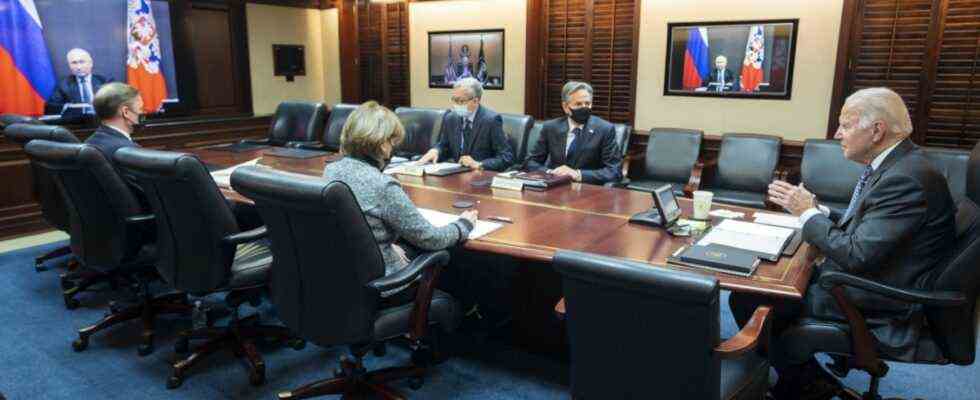The tension was high before the virtual summit of US President Joe Biden and Russian President Vladimir Putin. During their fourth meeting as heads of state, the two discussed for two hours. It was a very direct discussion, it was said afterwards. The last conversation took place in Geneva in the summer as a real summit – also after a Russian troop deployment on the Ukrainian border. These are the most important findings:
The climax of the tensions is only to come
It is a good sign that the presidents are talking to each other at all: this remark by Vladimir Putin’s spokesman before the summit shows how difficult the relationship is viewed by both sides. The discussion between the two superpowers is difficult; There was also no rapid progress on Tuesday, although the discussion lasted more than two hours. Biden suggested to Putin to rely on diplomacy instead of escalation, as his security advisor Jake Sullivan said after the video summit.
Putin demanded that NATO state in writing that it would not accept Ukraine. Biden strictly refused. After all: Biden and Putin have instructed their staff to sound out possibilities for a diplomatic solution. However, the tensions are unlikely to have reached their peak: In the past, Russia has fueled conflicts in order to consolidate its own negotiating position – or simply used talks as a fig leaf.
An economic war as a threat
Joe Biden’s message to Vladimir Putin at the virtual summit was clear: In an emergency, the United States would probably not defend Ukraine with its own soldiers. But should Russia invade Ukraine, it would have to pay a high price for it. Biden promised that the NATO countries would react “with strong economic and other measures”.
As a threatening backdrop, the US government let plans for far-reaching economic sanctions circulate in the run-up to the video summit. These would hit people close to Putin, for example with travel bans and the freezing of bank accounts. The US and the EU have already taken similar steps against Russian people and companies on several occasions after Russia annexed Crimea. So far, however, these sanctions have not been able to influence the behavior of the Kremlin.
The extreme variant ventilated by the USA would weigh more heavily: The western countries could exclude Russia from the international payment system Swift and impose additional restrictions on Russian banks. That would also severely restrict Russia’s access to international currency.
Nord Stream 2 is once again used as a means of pressure
The US has threatened Russia to block the Nord Stream 2 gas pipeline from Russia to Germany after all. Joe Biden had only just grudgingly given his consent to the management that Russia could use in the future as a means of pressure against the countries in the heart of Europe, as he fears. In order not to strain relations with Germany, however, he gave up his resistance.
Now that the pipeline is in the approval process at European level, the US is still considering disconnecting the billion-dollar project at the very last minute. In Congress, senior officials said Tuesday the US had made a deal with Germany: If Russia invades Ukraine, Nord Stream 2 will be unplugged. Security Advisor Sullivan confirmed this in clauses by saying that Nord Stream 2 was a top priority for the US – and that all steps would be coordinated with Europe. The Biden government had explicitly discussed this with both the resigning Merkel and the upcoming Scholz government.
Image of unity with Europeans
The US has spent 2.5 billion dollars on the Ukrainian defense since 2014. Biden Putin has now announced that he will provide Ukraine with additional weapons should Russia seek a military escalation, as security advisor Jake Sullivan said. If Russia were to invade Ukraine, the US would also arm the Eastern European countries and send additional troops, said Sullivan. US associations have already taken part regularly in exercises in Poland and the Baltic States; the troops rotate so that they are not considered to be permanently stationed. If Russia’s neighbors want additional US presence to feel safe, Biden will comply, Sullivan said. Biden tried to paint a picture of unity with the Europeans and to include them demonstratively: Before and after the conversation with Putin, he exchanged ideas with European representatives.

